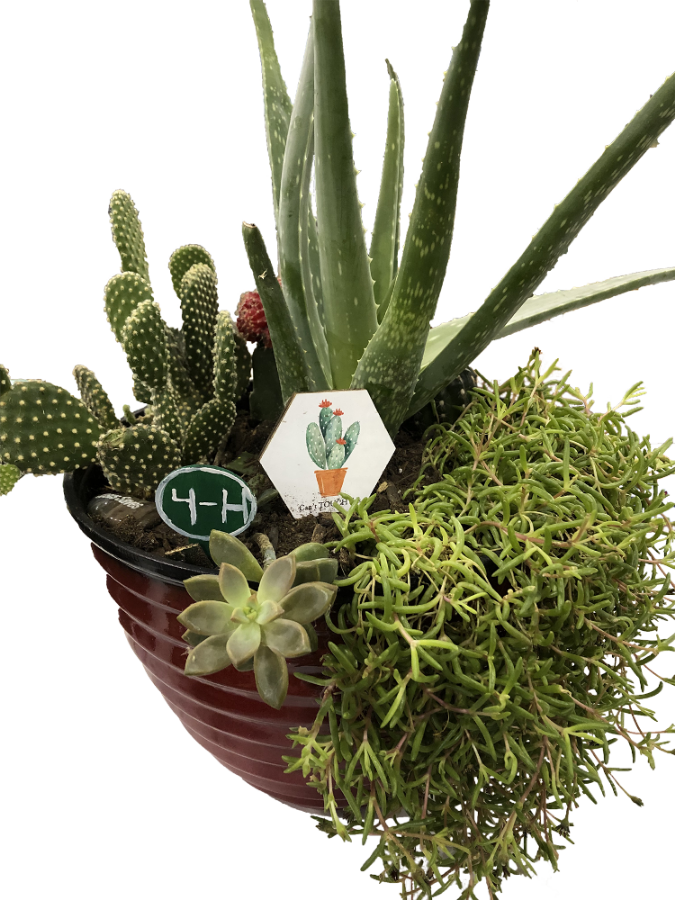Different Styles Of Dish Gardening
Dish Gardens
Published Oct. 2019 | Id: HLA 6451
By Shelley Mitchell, David Hillock
Dish gardens are a type of container garden, usually made with shallow, open dishes or bowls and with multiple plants in one container. The plants may be of the same or different species. Often, plants are chosen to add color or texture to a space, whether indoors or out.
The container chosen is up to the taste of the individual, but there are some basic considerations. A container needs to have enough room for the plants it will contain, as well as the media to support those plants. Drainage holes are another key factor. Do not use a layer of gravel at the bottom of the pot for drainage; a layer of gravel will actually hinder water movement away from roots. The composition of the container needs to be considered—plastic pots get brittle outdoors in the sun, and outdoor clay pots need more frequent watering, for example. Succulents don't need as deep a dish as other plants, since they can tolerate shallow rooting.
Plants used in dish gardens generally stay small or are slow growing. It is essential to select plants with similar watering and light needs for a successful dish garden. Planting a succulent, which needs a fast-draining soil to avoid overwatering, together with a nerve plant, which likes moist soil and thrives in high humidity, is going to create a difficult maintenance situation at best. Plants with similar growing conditions have the best chance at creating a pleasant, low-maintenance dish garden.
The media chosen for the pot will vary, depending upon the type of plants used; media should drain well, but hold adequate moisture and should not be very fertile. Fertile soil will encourage rapid growth. Fast-draining media contains sand, perlite and other ingredients that expedite drainage to prevent cactus and other succulents from sitting in water for too long.
When designing the dish garden, keep in mind that plants in groups of odd numbers (three, five, etc.) are often perceived as more aesthetically pleasing. Many people choose to make dish gardens similar to floral arrangements (Figure 1), with a "thriller" (tall plant in the middle), a "filler" (bushy plants that fill voids in the pot) and a "spiller" (trailing plants that hang over the side). Others like to use plants to make miniature scenes, complete with miniature hardscaping or figurines, to portray fairy gardens, jungle environments, or model parks. Dish gardens give free rein to creativity once the basic plant needs are met.

Figure 1. Examples of the concepts of thriller, filler and spiller.
When transplanting from nursery pots to a container, it is important to remove the plant properly to prevent damage to the roots of the plant (Figure 2). Place your hand over the top of the pot, putting half of your fingers on one side of the plant and half on the other side of the plant (making a "v" shape). Turn the pot upside-down and squeeze the edges of the pot. The plant should slide out on its own. Never pull the plant out of the pot; the roots could break.

Figure 2. Correct method of removing a plant from a pot. (Graphic courtesy of National Gardening Association).
To plant in a container, fill the container part way with potting media, so transplants will have their roots on top of the media, with room for downward growth. After arranging the plants, fill the container with potting media so that the plants have media to the same level as they did in their original pots. Burying the crown of a plant can lead to rot; planting too shallow will dry out the roots. When filling the container with media, be aware that settling will occur after watering. Tamp the potting media around the plants, but do not compress the mix so much that air pockets are removed. Leave some room between the top of the media and the top of the container, so media and water stay in the dish garden when watering.
Feel free to add items to your dish garden to create a fun display; be careful not to overdo it. The plants are the real stars of the dish garden!



Shelley Mitchell
Assistant Extension Specialist, 4-H Youth Development
David Hillock
Consumer Horticulture Specialist
- Share Fact Sheet
Was this information helpful?
YESNO
Different Styles Of Dish Gardening
Source: https://extension.okstate.edu/fact-sheets/dish-gardens.html
Posted by: kittrellkitn1938.blogspot.com

0 Response to "Different Styles Of Dish Gardening"
Post a Comment